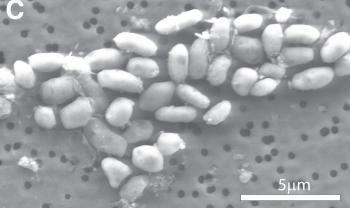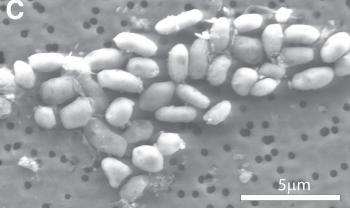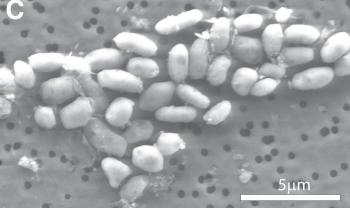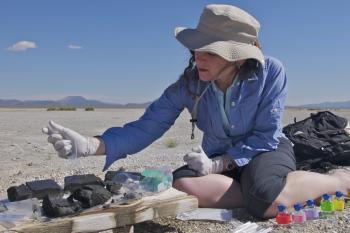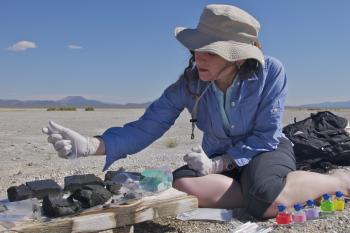A recent study suggests that we may have been overlooking life on earth and in space. The researchers found a bacterium that can grow with arsenic, a toxic substance, in substitution of phosphorus, which was previously thought to be essential for all life on Earth.
“We know that some microbes can breathe arsenic, but what we’ve found is a microbe doing something new—building parts of itself out of arsenic,” Dr. Felisa Wolfe-Simon, lead researcher of the study and NASA Astrobiology Research Fellow, said in a press release.
“It has solved the challenge of being alive in a very different way than we knew of,” Wolfe-Simon said in a press conference streamed live on NASA’s website Dec. 2. “It’s going to require at least some paragraphs in a textbook to be rewritten.”
The study, funded by NASA and published online Dec. 2 in the journal Science, used the bacterium GFAJ-1, a proteobacterium of the family Halomonadaceae, taken from Mono Lake in California.
Chemical Analogs
“Life is mostly composed of the elements carbon, hydrogen, nitrogen, oxygen, sulfur and phosphorus,” the researchers wrote in their research paper. “Although these six elements make up nucleic acids, proteins and lipids and thus the bulk of living matter, it is theoretically possible that some other elements in the periodic table could serve the same functions.”
Wolfe-Simon wanted to test bacteria’s ability to use arsenic as a substitute for phosphorus because of their similar chemical structures, she said in the press conference.
Phosphorus and arsenic are both in the nitrogen group of the periodic table, with arsenic being directly below phosphorus in the table. Elements that are directly above or below each other in the periodic table have similar properties as they have the same number of electrons on the outermost electron shell, and the difference in their number of electron shells is only one.
“Arsenic (in the oxidized 5+ state as arsenate) is biologically so similar to phosphate that many enzymes cannot recognize the difference,” Wolfe-Simon wrote on her website. “Inorganically, [arsenic] and [phosphorus] have very similar atomic radii and electronegativity (especially, compared to nitrogen which is directly above both on the periodic table).”
The scientists grew the bacterium with nutrients it needs, but added arsenic instead of phosphorus in its growth medium, which was “taken through many decimaldilution transfers greatly reducing any potential carryover of autochthonous phosphorus,” the researchers wrote in their paper.
“We found that not only did this microbe cope, or deal with the toxicity,” said Wolfe-Simon in the press conference, “but it grew and it thrived.”
Although the scientists have not found whether phosphorus is totally unused in the bacterium’s cells (because the cells have previously been made out of phosphorus), it did grow successfully without acquiring phosphorus. At least some arsenic is used in the bacterium’s biomolecules like DNA and ATP (which might now be ATAs given the new structure), occupying the spots in the molecules that have been known to be phosphorus.
This research suggests that there may be life on Earth and in space that uses arsenic and thus does not need phosphorus at all.
The Search for Life
In his 1990 book “Paradigms Lost: Images of Man in the Mirror of Science,” Mathematician John L. Casti explores different theories of the origin of life, considering different arguments for and against each. In the end he argues that the most plausible is chemist Alexander Graham Cairns-Smith’s model that life began with silicon crystal formations instead of carbon.
Given Wolfe-Simon and colleagues’ findings, there is now a stronger argument for the theories described in Casti’s book.
This indicates that elements like carbon, hydrogen, nitrogen, oxygen, and sulfur might possibly be replaced by their similar elements in some existing, but as of yet undiscovered, life. So in our search for life in space, we may have overlooked planets that don’t contain these elements but that actually do have life, with these forms of life using elements that differ from what we have previously thought of as life-creating materials.
“This is a huge finding and a significant finding that’s going to lead to new areas of research and will fundamentally change how we define life, and therefore how we look for it,” said Wolfe-Simon in the press conference.
“This will inform us about life on our own planet, and it will help inform us of life—we will find it one day—elsewhere in the universe.”
“As we pursue our efforts to seek signs of life in the solar system, we have to think more broadly, more diversely, and consider life as we do not know it,” Ed Weiler, NASA’s associate administrator for the Science Mission Directorate at the agency’s headquarters in Washington, said in a press release.
Wolfe-Simon and her colleagues are working on more studies on this topic. She expects to submit her next research paper in February.
